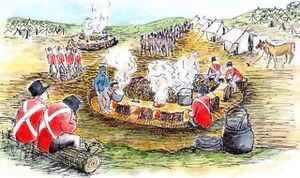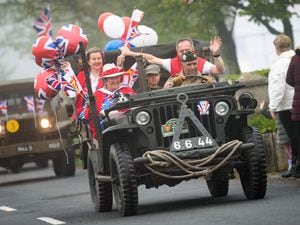'Bronze Age' site turns out to be rare Napoleonic army camp
A RARE Napoleonic era army camp has been discovered during a dig on L’Ancresse Common.

A team of archaeologists from Bristol-based Clifton Antiquarian Club have unearthed evidence of a British army training camp from the early 19th century on L’Ancresse Common.
The find came as a surprise – it had long been thought locally that the site dated from the Bronze Age.
The team of diggers were led by Dr Donovan Hawley and Laurie Waite, along with local volunteers, and they unearthed a host of finds, which allowed them to gradually piece together a picture which de-bunked the original premise that the mounds dated from the Bronze Age.
Dr Hawley said the find was still very important.
‘Our research thus far shows just four of these field kitchens have previously been excavated,’ he said.
‘One in England, one in Ireland and two in the USA, which emphasises the importance of this discovery in Guernsey. They are also likely to be unique as a surviving group of four.’
The work, funded by the Vale Commons Council, was carried out as part of ongoing research to understand the extent of the archaeological resource on the common.
The clues excavated by the team included the discovery of a clay pipe, which could only have been produced between 1803 and 1815, and a decorated button dating to the early 1800s. Sophisticated radiocarbon technology provided a complementary date for charcoal deposits taken from the site.
However the main archaeological prizes were 19th century army camp kitchens.
The kitchens were part of an army encampment most likely established as part of ongoing defences in the Channel Islands during the Napoleonic Wars.
The early 1800s were a time of heightened tension across the Channel Islands as an invasion from Napoleon’s forces was expected at any time.
Through research the Clifton team have found that the army camp in Guernsey had its kitchens all built to a standard British army design.
The dig found a circular ditch around eight metres across and clear signs that those constructing the catering facility had heaped the spoil in the centre which created a metre high mound.
Dr Hawley said he could understand why there had been confusion over the site.
‘It is easy to see why people formed the view that it could be a Bronze Age cemetery, as they have a similar appearance,’ he said.
‘But now with radiocarbon dating techniques we can be more accurate in our findings.
‘Our new research has established that each camp kitchen contained up to twelve simple fireplaces cut at regular intervals into the inner side of the ditch so that cooking could be carried out by soldiers sitting on the outer bank.’
The club’s outreach officer, John Swann, gave a talk on Guernsey’s prehistory to Elizabeth College and afterwards a group of students joined the excavation for a day.
Former Guernsey resident and Elizabeth College student Nicholas Thomas, 91, is the sole survivor of a 1947 dig, the only previous excavation known at the site.
He commented that he has been fascinated to learn of the new discovery.
Upon receiving news from the Bristol team, he said he was delighted that the puzzle of the mounds has finally been solved.





